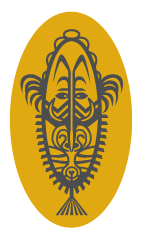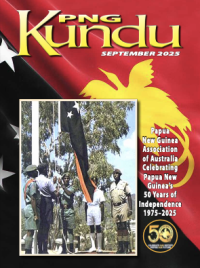REVIEWS
Featuring new books about PNG and reviews, art and craft exhibitions, interviews of interest to members and information for authors, artists and craftspeople
Andrew Macintosh: Fergusson Island: A Clash of Cultures
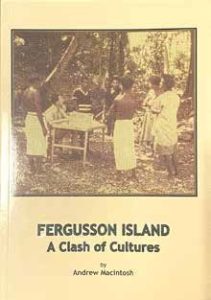 A story from Fergusson Island in the Territory of Papua, set in a period from the 1950s when the Territories were administered by the Australian Government, and a time when Christian missionaries had moved into remote areas to convert and educate the local people.
A story from Fergusson Island in the Territory of Papua, set in a period from the 1950s when the Territories were administered by the Australian Government, and a time when Christian missionaries had moved into remote areas to convert and educate the local people.
Traditional beliefs, laws and pursuit of Cargo Cult regularly clashed with the administration and Western laws imposed upon them, with potentially deadly results.
These are the overlapping stories of the Fergusson Islanders, the Australian patrol officers and missionaries living and working on Fergusson Island.
ISBN: 978-0-646-70436-4 Self-Published 2024, Cremorne1.com
Self-publishing, A5 size; 104 pp; Cost: $20 plus postage. Purchasers can order by email to andrewmacintosh59@gmail.com
SUSAN COCHRANE: Living Art: Papua New Guinea
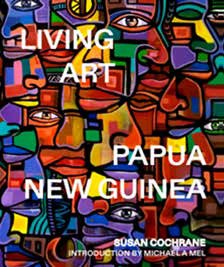 Living Art in Papua New Guinea brings alive the multiple contemporary realities of the country and its people. This full-colour art book—lavishly illustrated with over 100 photos—presents artworks and cultural performances that are astonishing for their dramatic visual effect and virtuosity. It is a highly visual experience of Papua New Guinea’s spectacular cultures and aesthetic wealth in their own context.
Living Art in Papua New Guinea brings alive the multiple contemporary realities of the country and its people. This full-colour art book—lavishly illustrated with over 100 photos—presents artworks and cultural performances that are astonishing for their dramatic visual effect and virtuosity. It is a highly visual experience of Papua New Guinea’s spectacular cultures and aesthetic wealth in their own context.
Culture, politics, history, and identity are interlinking themes through which the book presents ideas about artists, creative processes and aesthetics, revealing Papua New Guinea’s diversity of cultures and environments. It locates innovative artists in their villages, in downtown Port Moresby, and on to the international stage. Through this panorama, readers’ ideas about what art is may be challenged.
Released in the month of Papua New Guinea’s 50th Anniversary of Independence, this book explains and showcases the contemporary arts and culture of Papua New Guinea and its people, with a Preface by Honourable James Marape, Prime Minister of Papua New Guinea.
Dr Susan Cochrane is a researcher, curator and writer who works closely with communities and organisations in Papua New Guinea. Throughout her career, Dr Cochrane has been a staunch advocate for Pacific artists and writers, and she regularly collaborates with artists and writers from Indigenous Australian, Pacific Islander, and Papua New Guinean communities.
ISBN: 978-1922779403
Published by Melbourne Books; 336 pp; Hardback.
RRP $74.99
Please use this link:
https://melbournebooks.com.au/products/living-art-papua-new-guinea-pgk
ERIC JOHNS: A History of Papua New Guinean from Prehistory to Independence
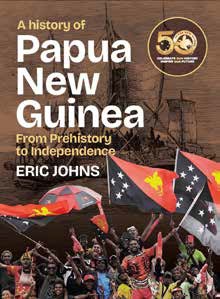 Every once in a while, a truly memorable, superlative book about Papua New Guinea (PNG) is released. Often the author will be an Australian who lived in PNG and fell in love with the land and its diverse peoples.
Every once in a while, a truly memorable, superlative book about Papua New Guinea (PNG) is released. Often the author will be an Australian who lived in PNG and fell in love with the land and its diverse peoples.
Eric Johns’ A History of Papua New Guinea from Prehistory to Independence is in the same class as the famous Professor Denoon’s, A Trial Separation. It is, however, a very different kind of history.
Whereas that book is a polemic, Johns’ book does not try to prove a point or win a constitutional debate. Instead, it patiently takes its readers on a long, instructive journey across the millennia from New Guinea’s early prehistory, through the centuries of it becoming progressively known to the outside world.
Moving on through its decades of colonisation by, first, the Netherlands, then Germany, Britain, Australia and Indonesia, the author demonstrates how the New Guineans became a commodity, units of labour in the Pacific plantation and mining industries.
Meanwhile, the colonial administrations sought to impose their systems of governance, while missionaries from various Christian denominations tried to save indigenous souls by spreading the Gospel, which necessitated the establishment of schools to impart literacy.
In the eastern half of New Guinea and the nearby archipelagos, which eventually coalesced into PNG, the village-based communities often resisted their assimilation into the colonial world. Many clashes occurred between them and the navigators, explorers, labour recruiters, gold prospectors, missionaries and district administrators. Countless lives were lost, always violently. Local conflicts continued into the 1970s, as at Kabaira on the Gazelle Peninsula, where aggrieved villagers murdered the District Commissioner, Jack Emanuel, in 1971. Eric Johns covers this highly controversial episode fully, and with commendable even-handedness.
Meanwhile, two world wars had engulfed the then separate territories of Papua and New Guinea. The second, from 1939 to 1945, saw the Japanese invading both territories and fighting tenaciously to retain their conquests. It was this war that prompted the administrative union of the two territories, setting them on their course towards PNG nationhood.
Eric Johns’ four chapters describing World War II provide an excellent summary of the war’s ebb and flow across PNG.
Eric Johns’ subsequent chapters, in which he charts PNG’s post-war progress towards independent nationhood, are the best exposition of that era that I have seen. He guides the reader through the maze of administrative, political, economic and constitutional controversies that PNG endured to achieve its independence. This came on 16 September 1975 almost exactly 30 years after World War II formally ended in PNG.
A History of Papua New Guinea from Prehistory to Independence is a beautifully produced volume. It is a big, substantial book but remains highly readable throughout. The logical division of each chapter into clearly marked sections helps the reader. So, too, does the author’s accessible prose style.
Unlike many ‘academic’ histories, this is one for the general reader. Thankfully, it does not try to align itself with any of the historiographical ‘isms’ beloved by those historians who write mainly for others of their ilk. Readers will appreciate the author’s effort to tell the PNG story simply and directly ‘as it really was’.
The task of reading Eric Johns’ 625 pages of complex history is greatly eased by the many maps and illustrations. The book averages almost one entrancing illustration per page, many of these rarely if ever published previously.
Inevitably, even the most detailed history will omit episodes that well-informed readers might wish to see discussed. One event I had hoped to read about was the 1953 murder of two patrol officers and two policemen near Telefomin in the Sepik highlands. I eventually found it, but it was consigned to a brief footnote in the chapter covering that period.
The absence of a discussion of the Telefomin killings, however, does not detract from Eric Johns’s achievement. A History of Papua New Guinea from Prehistory to Independence is the most complete introduction to modern PNG that I have seen. Anyone curious about whether PNG’s Independence in 1975 will eventually prove to have been ‘a trial separation’ from Australia will find much food for thought within its 25 carefully crafted chapters.
Ian Howie-Willis
Published by Chris Roering (Darnum, Victoria), 2025
ISBN: 978-0-646-72151-4, Hard copy, 631 pp; Note: This is a limited-edition production. Please contact eric@johns.com.au for further information.
